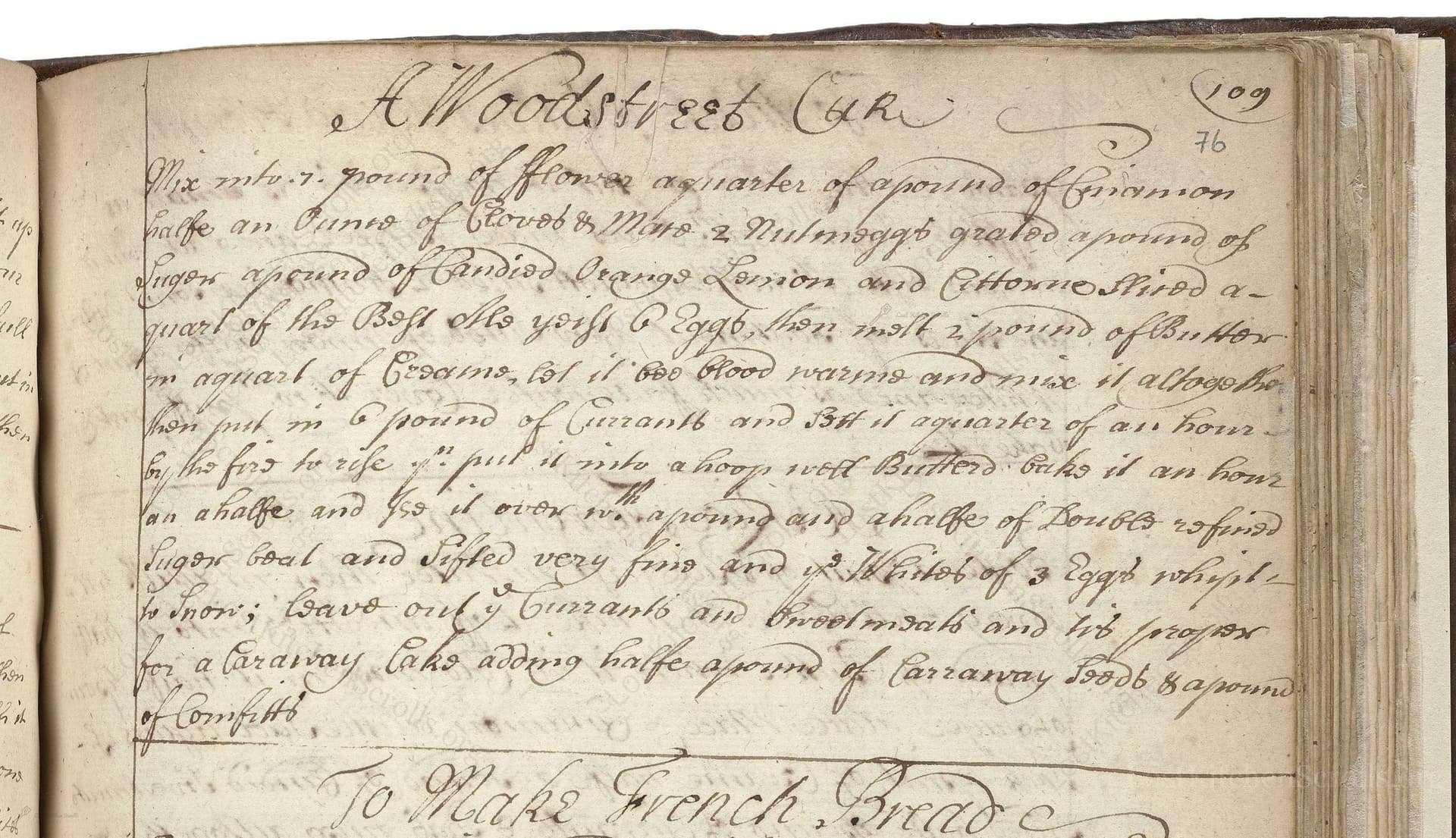A Woodstreet Cake
From the treasured pages of Cookbook of Grace Blome, Kent
Written by Grace Randolph

A Woodstreet Cake
"Mix with 1 pound of fflower a quarter of a pound of Cinamon halfe an Ounce of Cloves & Mace 2 Nutmeggs grated a pound of Sugor a pound of Candied Orange & Lemon a quart of the Best Ale yest 6 Eggs, then put in a pound of Currants and by the fire to rise yr put it into a hoop an a halfe and so it oven wth a pound of Sugor beat and Sifted very fine and to Snow; Save out yr Currants and for a Caraway cake adding halfe a pound of Comfitts."
Note on the Original Text
The recipe showcases the typical style of early modern English manuscript cooking: imprecise in measurement by contemporary standards (using pounds, ounces, and whole numbers) and assuming the reader had working kitchen knowledge. Diagnostic instructions—like 'by the fire to rise'—expect cooks to know basic fermentation, and operators are expected to adjust for their own hearths or ovens. Terms such as 'comfitts' refer to sugar-coated seeds, and 'hoop' meant a cake ring for shaping. The spelling reflects 17th-century conventions (e.g. 'fflower' for 'flour'), with abbreviated terms such as 'yr' for 'your.'

Title
Cookbook of Grace Blome, Kent (1697)
You can also click the book image above to peruse the original tome
Writer
Grace Randolph
Era
1697
Publisher
Unknown
Background
A delightful glimpse into late 17th-century kitchens, this culinary collection by Grace Randolph tempts taste buds with refined recipes and elegant flavors fit for a well-to-do English household. Journey through a banquet of historic treats and timeless techniques!
Kindly made available by
Folger Shakespeare Library
This Woodstreet Cake recipe comes from the late Stuart/early Georgian period of English history, specifically attributed to Grace Randolph (1674–1750) and dated 1697. Written into domestic manuscript collections, such recipes offer a taste of both elite and middle-class festive tables in London and its environs. Named possibly after Wood Street in London, the cake likely reflects bakery traditions of the area, characterized by rich use of spices, candied fruits, and leavening with ale yeast—signatures of celebration and prosperity in the age. The manuscript V.b.301 is a treasure trove of period recipes, showing the evolving palate and domestic practices in a time when sugar, spice, and dried fruits were expensive luxury goods.

Cooks of the period would have employed heavy ceramic or wooden mixing bowls, sturdy wooden spoons, and a sieve for 'beating and sifting' the sugar. The cake would be shaped in a 'hoop'—a bottomless metal or wooden cake ring—set on a baking sheet or directly on oven tiles. Ale yeast was obtained from local brewers, and the cakes were proofed near the kitchen hearth where warmth was plentiful. Baking was done in a wood-fired oven, carefully tended for even heat.
Prep Time
30 mins
Cook Time
1 hr
Servings
20
We've done our best to adapt this historical recipe for modern kitchens, but some details may still need refinement. We warmly welcome feedback from fellow cooks and culinary historians — your insights support the entire community!
Ingredients
- 1 lb plain (all-purpose) flour
- 4 oz ground cinnamon
- 0.5 oz ground cloves
- 0.5 oz ground mace
- 2 whole nutmegs, grated
- 1 lb caster sugar
- 8 oz candied orange peel, chopped
- 8 oz candied lemon peel, chopped
- 1.75 pints fresh brewer's yeast (or 0.75 oz active dry yeast as substitute)
- 6 large eggs
- 1 lb dried currants
- 1 lb icing (confectioner's) sugar
- 8 oz caraway comfits (for caraway cake option)
Instructions
- To make a Woodstreet Cake, begin by mixing 1 lb of plain flour with 4 oz ground cinnamon, 0.5 oz each of ground cloves and mace, and the grated zest of 2 nutmegs.
- Add 1 lb of caster sugar and 1 lb of chopped candied orange and lemon peel.
- Whisk 6 eggs, then blend in 1.75 pints of fresh brewer's yeast (or 0.75 oz active dry yeast dissolved in warm water as a substitute).
- Mix well, then stir in 1 lb of washed currants.
- Set the dough by a warm place to rise until roughly doubled in size.
- Prepare a round cake tin (a 'hoop') about 9–9.5 inches in diameter and 2–2.75 inches tall.
- Once the dough has risen, transfer it to the tin and bake in a moderately hot oven (around 350°F) until golden and cooked through; this may take 45–60 minutes.
- While still warm, sift 1 lb of icing sugar over the cake until it resembles snow.
- For a caraway cake variation, hold back the currants and instead add 8 oz of caraway comfits (sugar-coated caraway seeds).
Estimated Calories
480 per serving
Cooking Estimates
It takes about 30 minutes to prepare the ingredients and dough, and 1 hour to bake the cake. This cake serves about 20 people, with each slice containing around 480 calories.
As noted above, we have made our best effort to translate and adapt this historical recipe for modern kitchens, taking into account ingredients nowadays, cooking techniques, measurements, and so on. However, historical recipes often contain assumptions that require interpretation.
We'd love for anyone to help improve these adaptations. Community contributions are highly welcome. If you have suggestions, corrections, or cooking tips based on your experience with this recipe, please share them below.
Join the Discussion
Rate This Recipe

Den Bockfisch In Einer Fleisch Suppen Zu Kochen
This recipe hails from a German manuscript cookbook compiled in 1696, a time whe...

Die Grieß Nudlen Zumachen
This recipe comes from a rather mysterious manuscript cookbook, penned anonymous...

Ein Boudain
This recipe comes from an anonymous German-language manuscript cookbook from 169...

Ein Gesaltzen Citroni
This recipe, dating from 1696, comes from an extensive anonymous German cookbook...
Browse our complete collection of time-honored recipes



